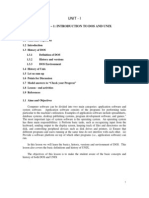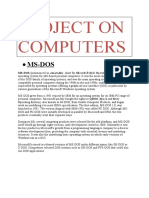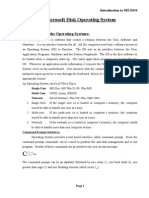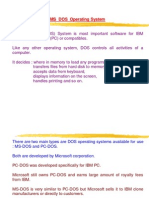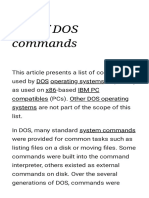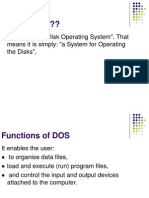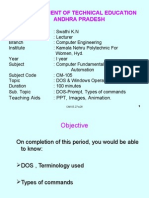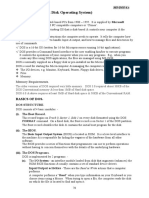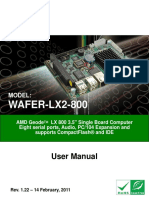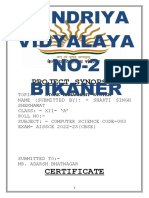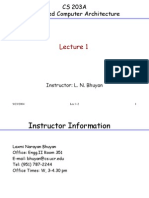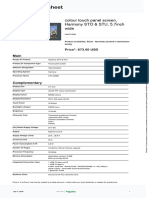Revision no.: PPT/2K403/02 Revision no.
: PPT/2K403/02
Disk Operating System
Revision no.: PPT/2K403/02
CMS INSTITUTE, 2004. All rights reserved. No part of this material may be reproduced, stored or emailed without the prior permission of Programme Director, CMS Institute
History of DOS
Towards the 1980s, a number of personal computers had
appeared on the market, based on 8-bit microprocessor chips
such as the Intel 8080.
IBM made the decision to enter the market with a 16-bit
processor, the Intel 8088.
IBM realized that it did not have time to develop its own
operating system and at that time CP/M written by Gary Kildall
from Digital Research dominated the market.
IBM had negotiations with Digital Research but the
negotiations did not result in an agreement.
IBM then had given the contract to write the new OS to
Microsoft.
Revision no.: PPT/2K403/02
CMS INSTITUTE, 2004. All rights reserved. No part of this material may be reproduced, stored or emailed without the prior permission of Programme Director, CMS Institute
History of DOS (contd)
In 1979, a small company called Seattle Computer Products
decided to write its own operating software to test some of its
Intel based products which was called QDOS (Quick and Dirty
Operating System) made by Tim Patterson.
Microsoft bought the rights to QDOS for $50,000 keeping the
IBM deal a secret from Seattle Computer Products.
Microsoft made slight changes to QDOS and then presented
"Microsoft Disk Operating System" or MS-DOS to IBM.
IBM PC was announced in August 1981, with version 1.0 of
MS-DOS.
More than 50 other hardware manufacturers also used DOS,
after IBM selected MS-DOS.
Revision no.: PPT/2K403/02
CMS INSTITUTE, 2004. All rights reserved. No part of this material may be reproduced, stored or emailed without the prior permission of Programme Director, CMS Institute
Microsoft DOS
Microsoft designed DOS to run on an 8086 processor and
never truly upgraded DOS to take advantage of the more
advanced Intel processors' protected mode.
MS-DOS remains as it began, a single-tasking OS.
Interface of DOS was command line, meaning that there was
no mouse, no menus, or any graphical components.
Text commands were entered from the keyboard and the
computer's response appeared as text on the monitor.
DOS manifests each program and piece of data as an
individual file.
Names are broken down into two parts: the filename and the
extension.
Revision no.: PPT/2K403/02
CMS INSTITUTE, 2004. All rights reserved. No part of this material may be reproduced, stored or emailed without the prior permission of Programme Director, CMS Institute
Microsoft DOS (contd)
Filenames can be no longer than eight characters and
extension, which is optional, can be up to three characters
long.
No spaces or other illegal characters (/ \ [ ] | < > + = ; , * ?) can
be used in the filename or extension.
The file name and extension are separated by a period, or
"dot." and this naming system is known as the "eight dot
three" (written as "8.3") system.
Examples of DOS filenames:
WORD.EXE
SYSTEM.INI
AJAY.DOC
Revision no.: PPT/2K403/02
CMS INSTITUTE, 2004. All rights reserved. No part of this material may be reproduced, stored or emailed without the prior permission of Programme Director, CMS Institute
Drives and Directories
DOS assigns a drive letter to each hard drive partition and to
each floppy or other disk drive.
DOS cannot support more than two floppy drives and are
assigned drive letters A: and B:
Hard drives start with the letter C: and can continue to Z: if
necessary.
DOS uses a hierarchical directory tree to organize the contents
of these drives.
Revision no.: PPT/2K403/02
CMS INSTITUTE, 2004. All rights reserved. No part of this material may be reproduced, stored or emailed without the prior permission of Programme Director, CMS Institute
DOS Structure: Three Main Files
DOS operating system is composed of three main files,
accompanied by roughly 80 support files.
Three main files of DOS are IO.SYS, MSDOS.SYS and
COMMAND.COM.
IO.SYS handles all the talking to the BIOS and hardware.
MSDOS.SYS is the primary DOS code, often called the kernel.
COMMAND.COM actually interprets commands typed into the
computer and passes that information to MSDOS.SYS. It is
also called the Shell or command interpreter.
Revision no.: PPT/2K403/02
CMS INSTITUTE, 2004. All rights reserved. No part of this material may be reproduced, stored or emailed without the prior permission of Programme Director, CMS Institute
DOS Commands
It has two types of commands
Internal Commands
Code for these commands is loaded into computers RAM
memory as part of the OS at boot up and these commands are
available at all time.
Egs. dir, del, md, cd, rd, type, time, date, cls etc.
External Commands
Code for these is kept as files on the boot disk or on the DOS
directory and must be loaded into RAM Memory when required.
DOS flushes the external commands from the memory to make
more room for other commands or applications.
Egs. format, xcopy, help, edit, sys, fdisk etc.
Revision no.: PPT/2K403/02
CMS INSTITUTE, 2004. All rights reserved. No part of this material may be reproduced, stored or emailed without the prior permission of Programme Director, CMS Institute
Design & Published by:
CMS Institute, Design & Development Centre, CMS House, Plot No. 91, Street No.7,
MIDC, Marol, Andheri (E), Mumbai 400093, Tel: 91-22-28216511, 28329198
Email: courseware.inst@cmail.cms.co.in
www.cmsinstitute.co.in









